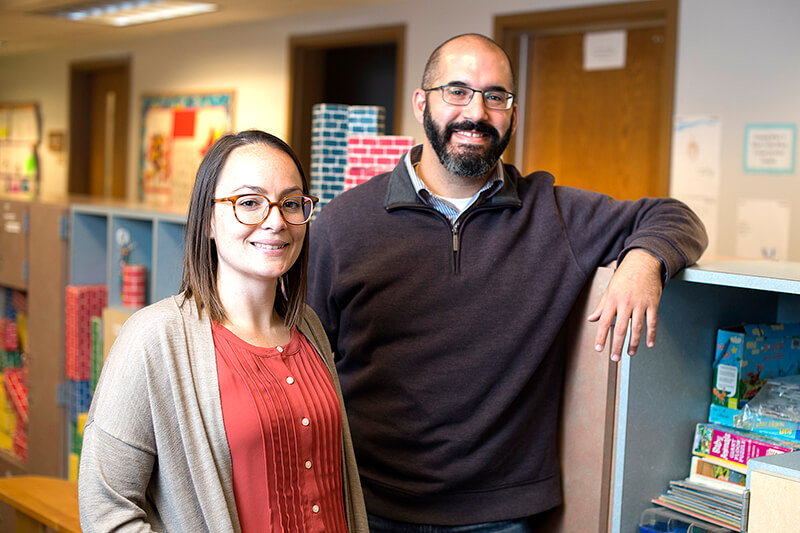November 9, 2017
Engaging children in math at home equals a boost in more than just math skills
 Amy Napoli, a doctoral student, and David Purpura, an assistant professor in the Department of Human Development and Family Studies, found that preschool children who engage in math activities at home with their parents not only improve their math skills, but also their general vocabulary. Their findings were published in the Journal of Experimental Child Psychology. (Purdue University photo/Mark Simons)
Download image
Amy Napoli, a doctoral student, and David Purpura, an assistant professor in the Department of Human Development and Family Studies, found that preschool children who engage in math activities at home with their parents not only improve their math skills, but also their general vocabulary. Their findings were published in the Journal of Experimental Child Psychology. (Purdue University photo/Mark Simons)
Download image
WEST LAFAYETTE, Ind. — Preschool children who engage in math activities at home with their parents not only improve their math skills, but also their general vocabulary, according to research from Purdue University.
“Exposure to basic numbers and math concepts at home were predictive, even more so than storybook reading or other literacy-rich interactions, of improving preschool children’s general vocabulary,” said Amy Napoli, a doctoral student in the Department of Human Development and Family Studies who led the study. “And one of the reasons we think this could be is the dialogue that happens when parents are teaching their children about math and asking questions about values and comparisons, which helps these young children improve their oral language skills.”
The findings are published online in the Journal of Experimental Child Psychology.
“It’s never too early to talk about numbers and quantities. One of the first words young children learn is ‘more,’” said David Purpura, an assistant professor in the Department of Human Development and Family Studies, and senior author of the study.
There are a number of ways parents can encourage math learning at home, such as talking about counting, connecting numbers to quantities and comparing values – more and less. It also helps to focus on counting as purposeful, such as “there are three cookies for a snack” rather than “there are cookies for a snack.”
“This focus on math typically isn’t happening at home, but this shows that when parents do include math concepts it can make a difference,” said Napoli, who is working on tools to help parents improve math-related instruction at home. “When working with families, there is a math-related anxiety aspect and that is probably why more parents focus on literacy than on math. But, if you can count, then you can teach something to your child.”
This study evaluated 116 preschool children, ages 3-5. The researchers assessed the children’s math and language skills in the fall and spring of the preschool year and examined how what their parents reported about math and literacy activities at home predicted children’s improvement over time. Napoli and Purpura do caution that these findings are only correlational and the future experimental work is needed to evaluate the causal nature of these findings. This research is ongoing work supported by Purdue’s Department of Human Development and Family Studies.
Writer: Amy Patterson Neubert, 765-494-9723, apatterson@purdue.edu
Sources: Amy Napoli, anapoli@purdue.edu
David Purpura, purpura@purdue.edu
Note to Journalists: Journalists interested in a copy of the journal article can contact Amy Patterson Neubert, Purdue News Service, 765-494-9723, apatterson@purdue.edu.
ABSTRACT
“The home literacy and numeracy environment in preschool: Cross-domain relations of parent-child practices and child outcomes.”
Amy R. Napoli, David J. Purpura
10.1016/j.jecp.2017.10.002
There is a growing body of evidence indicating that home literacy and numeracy environments are predictive of children’s literacy and numeracy skills within their respective domains. However, there is limited research on the relations between the home literacy environment and numeracy outcomes and between the home numeracy environment and literacy outcomes. Specifically, there is limited information on relations between the home numeracy environment and specific literacy outcomes (e.g., vocabulary). The purpose of the current study was to investigate the relations of the home literacy and numeracy environments to children’s literacy and numeracy outcomes both within and across domains. Participants were 114 preschool children and their parents. Children ranged in age from 3.01 to 5.17 years (M- 4.09 years) and were 54% female and 72% Caucasian. Parents reported the frequency of parent-child literacy (code-related practices and storybook reading) and numeracy practices. Children were assessed in the fall and spring of their preschool year on their literacy (definitional vocabulary, phonological awareness, and print knowledge) and numeracy skills. Four mixed-effects regression analyses were conducted to predict each of the child outcomes. Results indicate that although code-related literacy practices and storybook reading were not broadly predictive of children’s literacy and numeracy outcomes, the home numeracy environment was predictive of numeracy and definitional vocabulary outcomes. These findings demonstrate a relation between the home numeracy environment and children’s language development and contribute to the growing body of research indicating the important relations between early numeracy and language development.
Related website:
College of Health and Human Sciences
Related research:
Empowering preschool children with the language of math adds up to stronger skills

